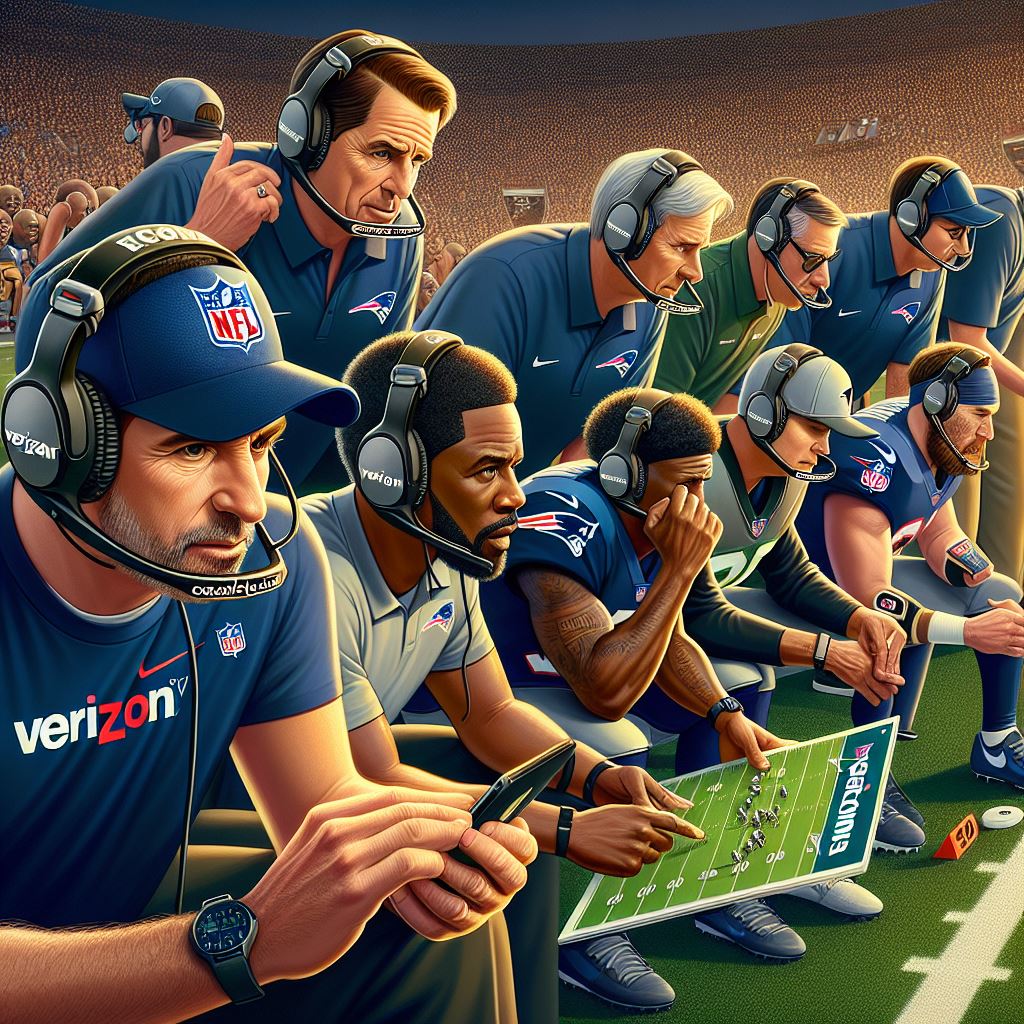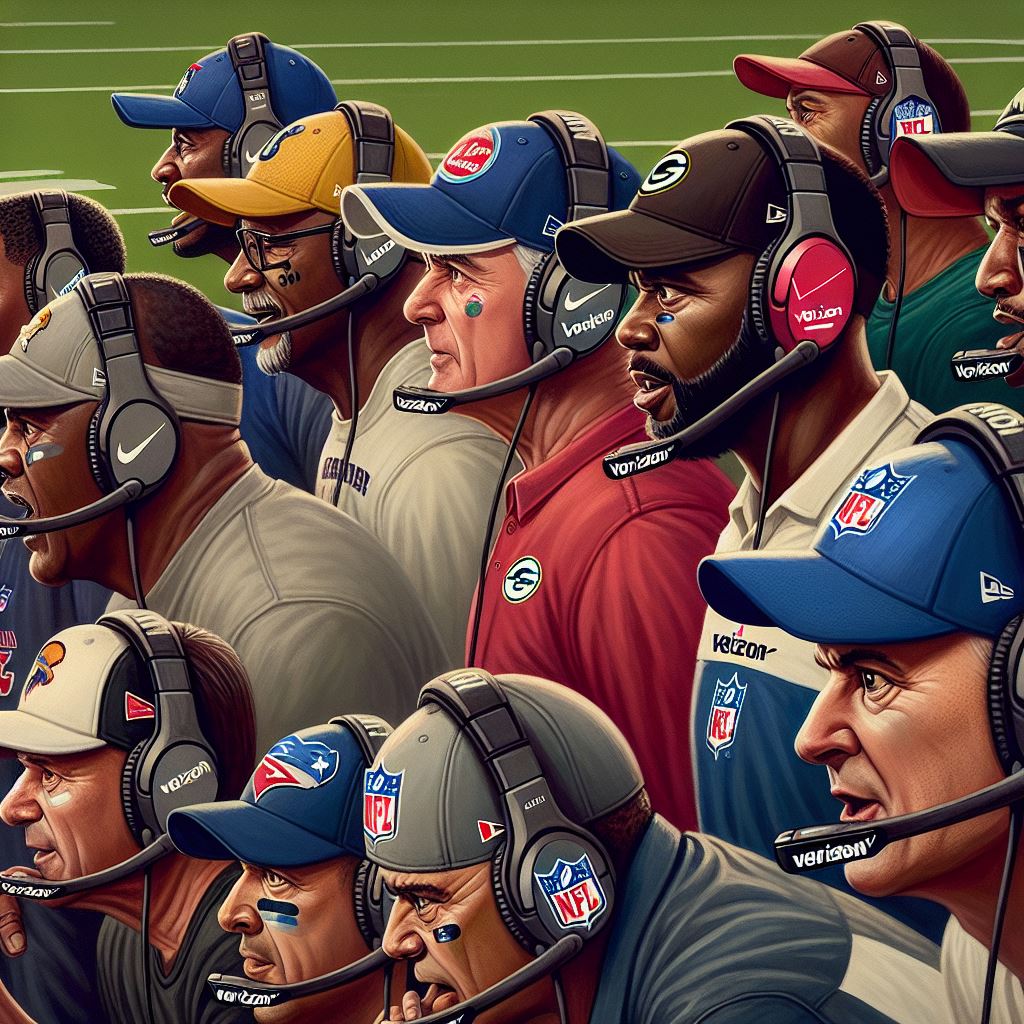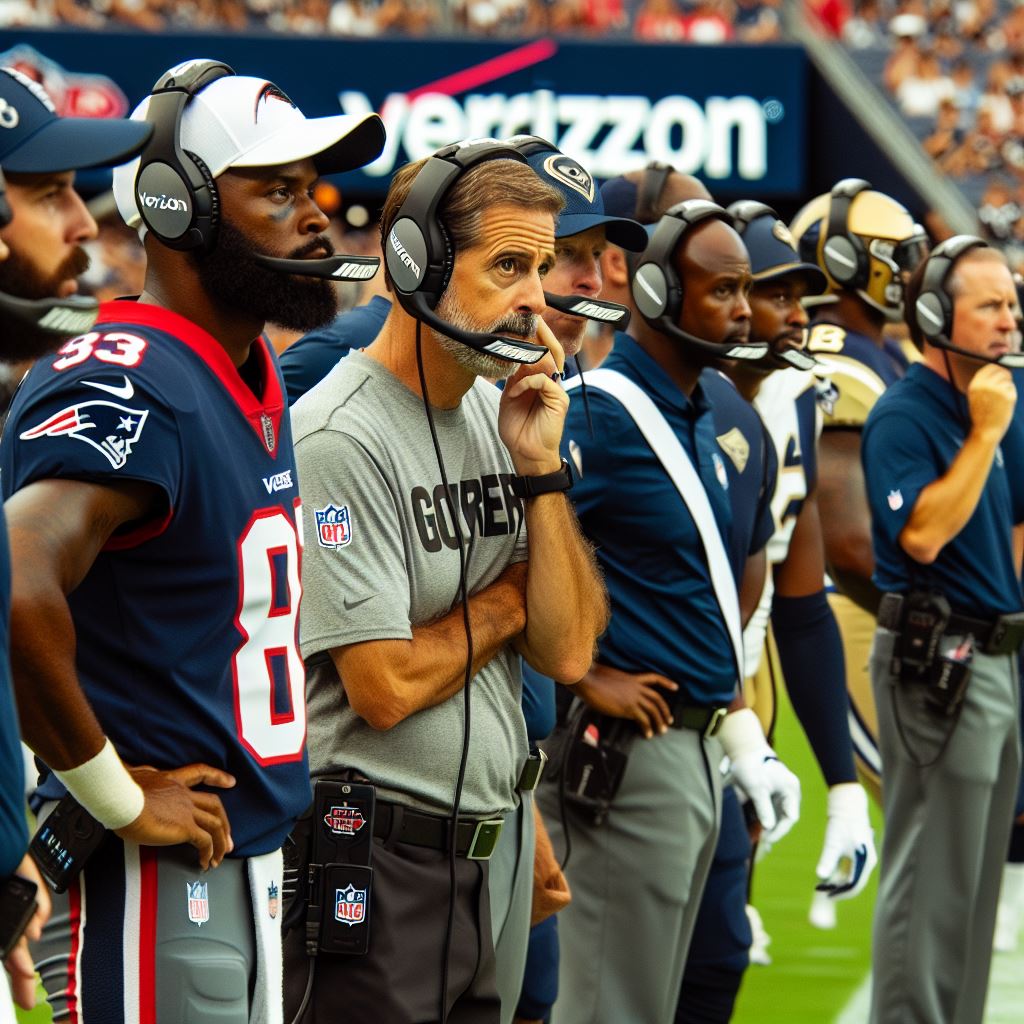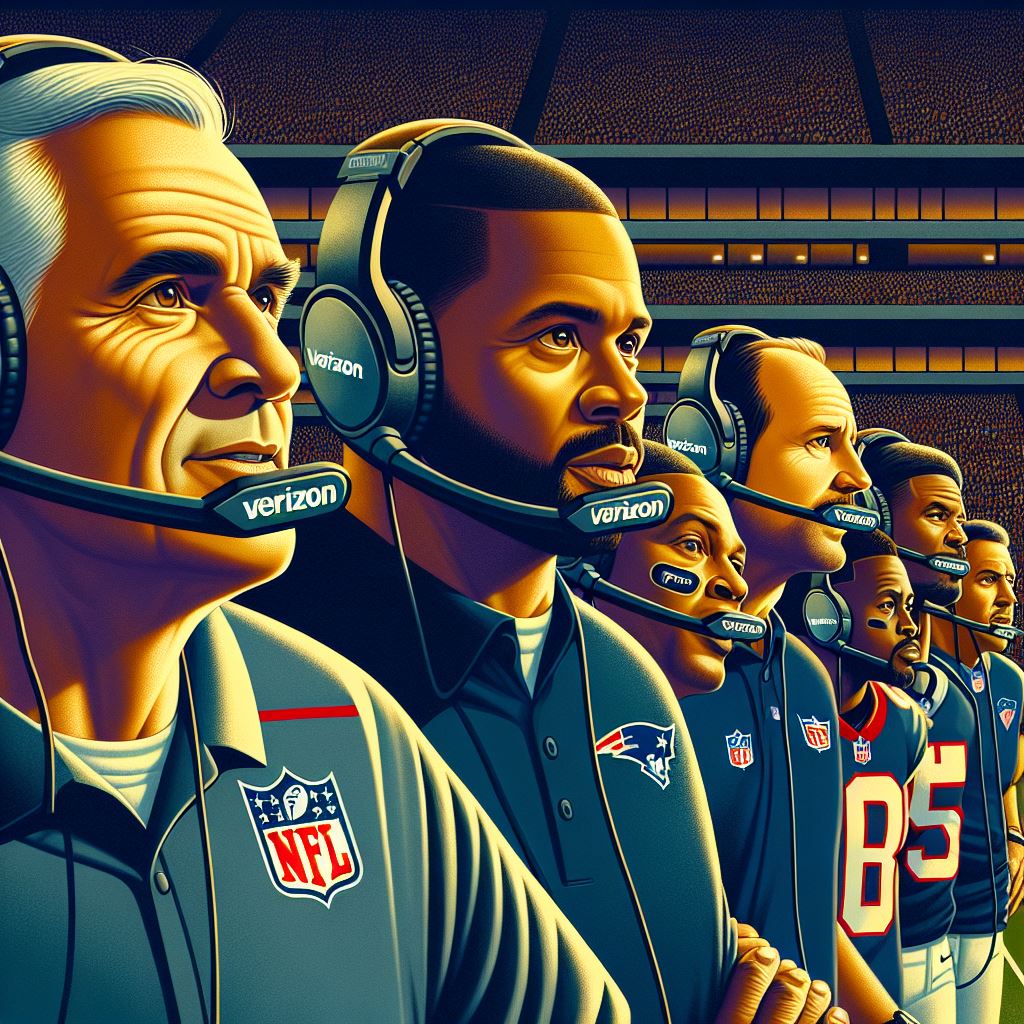Back to Football Tech Main Page
Overview of Verizon’s Coach-to-Coach Communication System
Verizon’s coach-to-coach communication system is a state-of-the-art solution designed to ensure reliable and seamless communication between coaches during NFL games. This system leverages Verizon’s Managed Private Wireless Solution, which provides a dedicated network for in-game communications, ensuring minimal latency and high security. Verizon’s Coach-to-Coach Communication System is part of their Managed Private Wireless solution, which was officially launched for the 2023 NFL season. This system is now live in all 30 NFL stadiums.

The Sideline Lifeline: How Verizon Powers Coach Communication in the NFL
In the fast-paced, high-pressure world of NFL football, instant and crystal-clear communication between coaches on the sideline and in the booth is absolutely critical. Every second counts, and a missed call or a garbled instruction can change the course of a game. That’s where Verizon steps in, providing a state-of-the-art system designed to ensure seamless communication for all 32 NFL teams.
Unveiled for the 2023 NFL season, Verizon’s Coach-to-Coach Communication System is now live in all 30 NFL stadiums, built on the backbone of their robust Managed Private Wireless Solution.
Think of it as a dedicated, secure network specifically designed for the unique environment of an NFL game.
Key Features That Keep Coaches Connected:
What makes this system so reliable in the heat of the moment? It comes down to several crucial components and features:
-
A Dedicated Private Wireless Network:
- The Foundation: This isn’t just tapping into public Wi-Fi. Verizon deploys a Managed Private Wireless Network within each stadium. This creates a secure, high-performance network slice used only for the coach communication system, minimizing interference and ensuring priority traffic.
- Current Technology (CBRS): The system currently operates using the CBRS (Citizens Broadband Radio Service) radio frequency. This specific band (around 3.5 GHz) is set aside for private use, acting like a dedicated highway for coach communications, keeping them separate from crowded public airwaves. This guarantees an interference-free channel crucial for real-time talk.
- Future (5G Integration): Looking ahead, Verizon plans to integrate 5G technology. While CBRS provides a reliable foundation now, 5G offers superior bandwidth and even lower latency. As 5G infrastructure continues to expand within stadiums, it will gradually enhance or potentially take over primary communication duties, unlocking new possibilities.
-
Cutting-Edge Coach Headsets:
- Built for the Noise: NFL stadiums are loud! The headsets used by coaches are specifically designed to combat this.
- Specifications: Featuring advanced noise-canceling technology, these headsets filter out roaring crowds and sideline commotion, allowing coaches to hear each other clearly. They are also built for comfort, essential for wearing throughout an entire game. Starting in 2025, Sony is the official brand providing these critical communication tools.
-
Constant In-Game Support and Monitoring:
- Behind-the-Scenes Reliability: A high-stakes game requires a system that simply works. Verizon provides comprehensive real-time monitoring of the network and all connected devices.
- Proactive Problem Solving: This allows them to quickly detect and address any potential technical glitches the moment they arise. Verizon also has on-site support teams in each stadium during games, ready to provide immediate assistance, ensuring coaches stay focused on the game, not technical difficulties.
-
Ironclad Security and Encryption:
- Keeping Calls Private: The strategic conversations between coaches are highly sensitive. Security is paramount to prevent unauthorized access or eavesdropping, protecting the integrity of the game plan.
- Advanced Protection: The system employs end-to-end encryption for all voice communications. This means that conversations are scrambled from the moment they leave one headset until they reach the intended recipient, ensuring only authorized users can listen in.
CBRS vs. 5G: A Look at the Technology Under the Hood
The transition from current CBRS use to future 5G integration highlights the evolution of the system:
- CBRS (Current Use):
- Benefits: Provides a dedicated, private, and secure channel with good reliability and low interference in the specific stadium environment.
- Limitations: Has more limited bandwidth and higher (though still low) latency compared to 5G.
- 5G Technology (Future Integration):
- Benefits: Offers significantly higher bandwidth (for more data), ultra-low latency (near-instantaneous communication), and enhanced capacity to connect more devices. It also opens the door for integrating more advanced features.
- Limitations: Requires substantial infrastructure investment for full deployment across stadiums and high-frequency signals have shorter range, requiring more base stations.
How 5G Will Enhance the System:
The integration of 5G isn’t just about faster voice calls. It will enable exciting new features:
- Real-Time Data & Analytics: Imagine coaches getting instant access to advanced player performance metrics or strategic data overlays directly through their system.
- Potential for AR/VR: While perhaps further off, 5G could eventually support augmented or virtual reality applications for coaching or training within the stadium.
- Improved IoT Integration: Connecting various Internet of Things (IoT) devices for enhanced monitoring or functionality.
By combining a dedicated private network, cutting-edge hardware, vigilant support, robust security, and a clear path for technological evolution with 5G, Verizon’s Coach-to-Coach Communication System is a vital, high-tech backbone for every play in the NFL.

Applications and Benefits
The Impact On and Off the Field: Benefits of Verizon’s Coach Communication System
So, we know what Verizon’s system is and the technology behind it. But what does this reliable, high-speed communication actually do? Its benefits ripple throughout the game, affecting everything from strategic calls on the field to the experience of fans watching at home.
Here’s a look at the key applications and advantages:
1. Sharper Game Management
In a sport decided by inches and split-second decisions, flawless communication directly impacts a team’s ability to execute its strategy.
- Real-Time Strategic Decisions: Coaches can instantly discuss the opponent’s formation, react to a sudden change in momentum, or call a critical audibe. The ability to make real-time decisions without delay is absolutely vital for staying ahead in a dynamic game.
- Seamless Strategic Coordination: From the head coach in the booth to coordinators on the sideline and position coaches, everyone needs to be on the same page. The system ensures strategic coordination, allowing the entire coaching staff to share insights, adjust the game plan, and maintain a unified approach throughout all four quarters.
2. Contributing to Player Safety
While not a direct medical tool, efficient communication plays a role in quickly addressing player health concerns.
- Expedited Injury Response: When a player goes down, clear and immediate communication between sideline medical staff, athletic trainers, and coaches is paramount. The system facilitates rapid injury management, ensuring the right personnel are alerted instantly and can reach the player quickly to provide prompt assessment and care, helping to prevent further injury.
- Smarter Substitution Management: Coaches need to rotate players effectively to keep them fresh and utilize specific personnel for different situations. Reliable communication allows for efficient substitution coordination, ensuring the correct players are on the field at the opportune moment, which helps maintain peak team performance and can reduce the risk of fatigue-related mistakes or injuries.
3. Boosting Operational Efficiency
At its core, the system is about making the technical side of communication disappear, allowing coaches to focus on football.
- Uninterrupted Communication Flow: Thanks to the dedicated private network and high-quality hardware, communications are seamless and uninterrupted, even in a packed and electronically noisy stadium. Coaches don’t have to worry about dropped calls or interference.
- Instantaneous Reactions: The low-latency network means there’s virtually no delay in voice transmission. This allows coaches to react instantaneously to critical game situations, enabling timely decisions on things like calling a timeout before a penalty, challenging a controversial play, or getting a crucial instruction to the field before the snap.
4. Enhancing the Fan Experience
The benefits extend beyond the sidelines, contributing to how fans engage with the game.
- Deeper Broadcast Insights: Data facilitated by the communication system (like which coach is talking to whom at a critical moment, or potentially integrating audio snippets where permitted and appropriate) can be woven into the broadcast integration. This provides viewers with insights into the strategic conversations and decision-making processes, offering a richer, more informed viewing experience and a deeper understanding of the game’s nuances.
- Fueling Interactive Engagement: The reliable network infrastructure that supports this system also contributes to the overall connected stadium environment. This can enable more sophisticated interactive features for fans through mobile apps and other platforms, such as accessing real-time data, participating in polls, or enjoying multiple camera angles – all of which enhance engagement and bring fans closer to the action.
By providing a robust, secure, and low-latency communication backbone, Verizon’s system is not just a tool for coaches; it’s an integral part of the modern NFL, contributing to better-managed games, enhanced player safety protocols, smooth operations, and a more engaging experience for fans watching around the world.
Football Tech
Future Developments
The Future of Sideline Tech: What’s Next for Coach Communication
The current Verizon coach communication system in the NFL is already a significant technological leap, providing reliable and secure real-time talk. But the evolution of this system, particularly with the integration of 5G and other advancements, holds the potential for even more transformative capabilities down the line.
Here’s a glimpse into the exciting future developments for this critical sideline technology:
1. Deeper Integration with Advanced Technologies
The seamless network established for coach communication is a prime foundation for layering on more sophisticated tools.
- Powering Advanced Analytics: With the low latency and high bandwidth offered by 5G integration, the system can become a pipeline for real-time data flowing directly to coaches. Imagine advanced analytics and machine learning models processing game data as it happens, providing coaches with real-time insights and recommendations. This could range from identifying subtle defensive tendencies to suggesting optimal play calls based on situational data, truly helping coaches make more informed decisions and optimize their strategies on the fly.
2. Expanding Beyond the Sideline
The dedicated private wireless network and robust communication infrastructure have potential applications that reach beyond just coach-to-coach talk during the game.
- Enhancing Stadium Operations: The reliable network could be leveraged to support other critical aspects of stadium operations. This might include improving coordination for security personnel, optimizing crowd management flow, streamlining communication for concessions staff, or even managing smart stadium features. This expansion would enhance the overall efficiency, safety, and fan experience within the stadium environment.
- Revolutionizing Training and Practice: The same communication and data capabilities used on game day can be brought to the practice field. The system could be used during training and practice sessions to provide real-time feedback and analysis to both coaches and players. This could involve instant audio feedback on technique, sharing performance data during drills, or facilitating realistic simulated game scenarios, allowing teams to improve their preparation and performance more effectively throughout the week.
3. Fortifying Security to Meet Future Threats
As technology advances, so do potential security risks. Future developments will focus on ensuring the system remains impervious to unauthorized access.
- Implementing Biometric Authentication: To add an extra layer of security and ensure the integrity of the system, future versions could include biometric authentication. This means access to the communication channels could require a fingerprint or facial recognition scan, guaranteeing that only authorized coaching and support staff can utilize the system.
- Adopting Advanced Encryption: Staying ahead of emerging cyber threats is crucial. The system could incorporate advanced encryption technologies, potentially including future concepts like quantum encryption. This would further enhance the end-to-end encryption already in place, protecting against sophisticated eavesdropping attempts and ensuring the absolute confidentiality of strategic communications in real-time.
These future developments paint a picture of a coach communication system that is not only reliable for voice but also acts as an integrated platform for data, operational support, and enhanced security, further solidifying technology’s role in the strategic heart of NFL football.
Conclusion
Verizon’s coach-to-coach communication system is a critical component of the NFL’s game-day operations, providing reliable, secure, and high-performance communication between coaches. By leveraging advanced technologies and dedicated support, the system enhances game management, player safety, operational efficiency, and the fan experience. As technology continues to evolve, the future of coach-to-coach communication in the NFL promises even more innovative applications and improvements, ensuring that the league remains at the forefront of sports technology.



